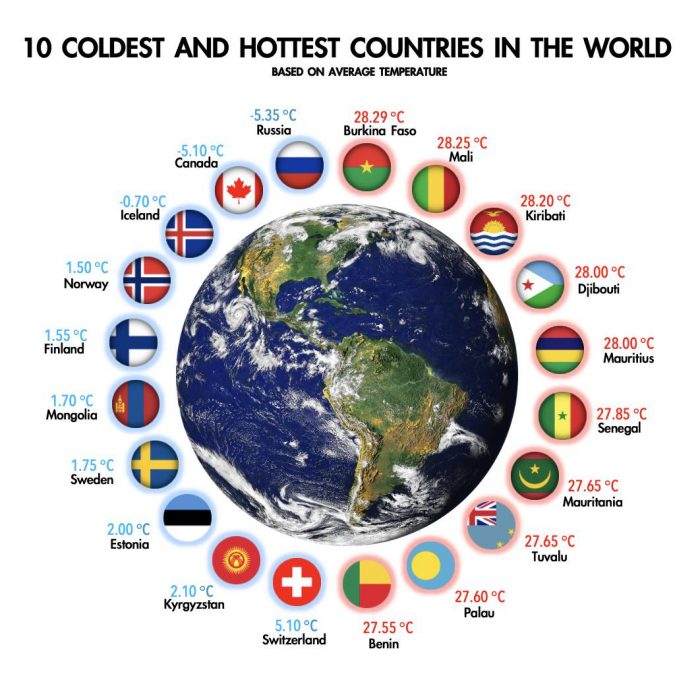
Get Infographics Right to Your Inbox
Sign up to receive the daily infographic in your email inbox each morning...
Knowing which countries experience the most extreme temperatures provides fascinating insights into geography, climate, and how societies adapt to live in harsh conditions. While most habitable places on Earth lie in the mild mid-latitudes, some parts of the world see scorching heat or bitter cold on a regular basis. The hottest and coldest countries represent two extremes of human habitation, requiring unique infrastructures, behaviors, and accommodations. Sweltering nations like Burkina Faso and Mali in West Africa contrast sharply with frigid realms including Russia, Canada, and Iceland.
Exploring the hottest and coldest countries provides a window into climate science, human geography, history, and the future challenges facing vulnerable parts of the world. This spectrum of heat and cold reveals the amazing adaptability of human societies, yet also their limitations. Some of the hottest locales may become uninhabitable in coming decades, even as the coldest places warm and transform. From cultural traditions to groundbreaking innovations, humanity continues displaying remarkable creativity in the face of temperature extremes.
Hottest Countries
The hottest countries in the world based on average annual temperature are:
-
Burkina Faso (28.29 °C)
-
Landlocked country in West Africa
-
Arid, hot climate
-
Prone to droughts and floods
-
Agriculture employs 80% of population
-
-
Mali (28.25 °C)
-
Landlocked country in West Africa
-
Mostly flat terrain, arid and semi-arid climate
-
Agriculture accounts for 40% of GDP
-
Cotton and gold are major exports
-
-
Kiribati (28.20 °C)
-
Island country in the Pacific Ocean
-
Low-lying coral atolls with tropical climate
-
Population just over 110,000
-
Highly vulnerable to sea level rise
-
-
Djibouti (28.00 °C)
-
Country in the Horn of Africa
-
Hot, arid climate with minimal rainfall
-
Important port nation
-
French, Arabic, and Somali widely spoken
-
-
Mauritius (28.00 °C)
-
Island nation in the Indian Ocean
-
Tropical climate year-round
-
Popular tourist destination famous for beaches
-
Multiethnic population with Indian heritage
-
Coldest Countries
The coldest countries in the world based on average annual temperature are concentrated in the northern latitudes, where frigid Arctic air masses predominate. The top 5 coldest are:
-
Russia (-5.35 °C) – Russia is the coldest country, with an average annual temperature of -5.35°C. Siberia registers astonishingly low temperatures, sometimes below -50°C in winter. Only the more temperate west and south of Russia, areas like St. Petersburg and Sochi, have milder winters.
-
Canada (-5.10 °C) – Canada’s northern latitude and sparse population lead to an extremely cold mean annual temperature of -5.1°C. The sparsely inhabited Northwest Territories and Yukon can see winter temperatures of -40°C. Even major cities like Toronto and Montreal have below freezing winters.
-
Iceland (-0.70 °C) – Despite being surrounded by the relatively warm Atlantic Ocean, Iceland has a year-round cold temperature averaging -0.7°C. In the Highlands region in the interior of Iceland winter temperatures regularly fall below -20°C. The capital Reykjavik has mild summers but cold and windy winters.
-
Norway (1.50 °C) – Norway’s northerly position and extensive Arctic territories like Svalbard give it a cold mean annual temperature of 1.5°C. Svalbard is one of the world’s northernmost inhabited places, with February averages around -16°C. Meanwhile, even southern Norway can see below freezing winter temperatures.
-
Finland (1.55 °C) – Located adjacent to Arctic Russia, Finland has a cold year-round climate with an average temperature of 1.55°C. The northern regions of Lapland can see extremes of -45°C in winter, while summer highs average a mild 15°C in the south. Helsinki on the southern coast has milder weather than far northern Finland.
Extreme temperatures on either end of the spectrum pose significant challenges for countries around the world. The hottest countries, concentrated in Africa, face issues like drought, famine, and disease outbreaks that can threaten lives and livelihoods. Meanwhile, the coldest countries like Russia, Canada, and Norway require substantial infrastructure investments and adaptations to make areas habitable and productive. While the causes of temperature extremes relate partly to geographic location and prevailing climate systems, global climate change is exacerbating these effects. Record high temperatures are becoming more frequent even in typically cold regions. Going forward, all countries will need to prioritize climate mitigation and adaptation strategies to protect populations.
Tourism can provide economic opportunities for both very hot and very cold countries. But it also comes with environmental and social impacts that must be carefully managed. With climate change accelerating, striking the right balance will only grow more complex. In summary, extreme hot and cold temperatures create an array of challenges and require innovative solutions. All countries have a vested interest in reducing greenhouse gas emissions and finding ways to adapt to a changing climate. This will require global cooperation, technological innovation, and community resilience in the decades ahead. More study is needed to fully understand the cascading impacts of temperature extremes and develop effective policies and practices. But facing this pressing challenge head-on provides opportunities to build a more sustainable world.
